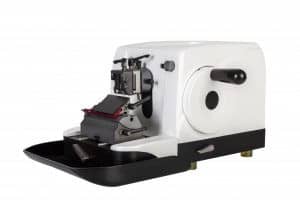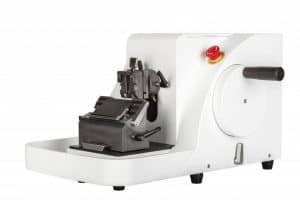We at Precisionary Instruments have been making tissue slicers for over 15 years. Now, we would like to launch a brand new product line: ROTARY MICROTOMES!
A microtome makes tissue sections by making cuts that move vertically downward against a knife. A “rotary” microtome uses a rotational handwheel to control the cutting movement (see Figure 1). One rotation of the operating wheel produces a complete cycle of cutting (both downward and upward strokes). A rotary microtome can be used to cut ultrathin sections, often paraffin-wax embedded sections for pathology and histology studies.

We offer three (3) brand new models:
To help you learn more about our rotary microtome models, here are the technical specifications in a simple and fun comparison table!
 |  |  |
|
|---|---|---|---|
| Rotary Microtome Model | RF-600 | RF-800 | RF-1000 |
| Microtome Type | Manual | Semi-Automated | Fully Automated |
| Section Thickness Range | 0μm – 60μm adjustable as follows:
2μm – 10μm (in 1μm increments) 10μm – 20μm (in 2μm increments) 20μm – 60μm (in 5μm increments) | 0-99.9μm (in 0.1 μm increments) | 0.5μm – 100μm adjustable as follows:
5μm – 20μm (in 1μm increments) 20μm – 60μm (in 5μm increments) 60μm – 100μm (in 10μm increments) |
| Trimming Thickness Range | 0μm – 60μm adjustable as follows:
2μm – 10μm (in 1μm increments) 10μm – 20μm (in 2μm increments) 20μm – 60μm (in 5μm increments) | 0-999μm (in 0.1 μm increments) | 5μm – 600μm adjustable as follows:
10μm – 100μm (in 10μm increments) 100μm – 200μm (in 20μm increments) 200μm – 600μm (in 50μm increments) |
| Minimum Section Thickness | 0.5µm | 0.1µm | 0.5µm |
| Specimen Retraction | None | 0-99μm (Optional on/off) | 0-220μm (Optional on/off) |
| Horizontal Specimen Stroke | 23mm | 28mm | 20mm |
| Vertical Specimen Stroke | 58mm | 57mm | 60mm |
| Specimen Head Rotation | 7-degrees rotation in X-Y axes | 4-degrees rotation in X-Y axes | 8-degrees rotation in X-Y axes |
| Specimen Feed Speed | Coarse handwheel (manual) | Electronically adjustable | Electronically adjustable |
| Dimensions (L x W x H) | 22 in x 16 3⁄4 in x 11 1⁄2 in | 22 3⁄4 in x 16 in x 12 9/16 in | 19 1⁄2 in x 16 7/8 in x 12 in |
| Weight | 54 lb | 67 lb | 60 lb |
| Voltage & Power | None | 100-120V, 60Hz | 100-120V, 60Hz |
| Additional Accessories (Included for FREE!) |
|
|
|
At Precisionary Instruments, we’re thrilled to shine a spotlight on innovative labs around the world that are advancing science in unique and meaningful ways. This
Artificial Cerebrospinal Fluid (ACSF) is an essential buffer solution widely used in electrophysiology experiments, particularly to keep acute brain slices alive during research. This solution closely mimics the natural cerebrospinal fluid found in the brain and is designed to maintain neuronal viability and function during experiments like patch-clamp recordings. In this article, we’ll explore the importance of ACSF, its composition, and practical tips to optimize its use.
You’ll hear back from us in one business day
© 2023 Copyright
*Academic discounts are only valid for customers in North America.
© 2023 copyright